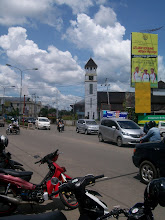
To let the mangroves grow in its wild environment is the duties for all of us who care and have responsible feeling to save it. This picture is also tell us how the naturally and wildly grow mangroves become important to save and protect the environment as well. Not only from flooded water to our neighborhood, but also from abrasion. This is where mangroves may reach eight metres in its height as there are no people's hand interfere their growth and existence. This is also beneficial to another living creatures who live in and around mangrove trees; such as crabs, birds, bats, crocodiles, fish, snakes, and many more types of insects. When the mangroves gone, all of these living creatures will also gone in line with the mangroves destruction. If there are no fishpond or shrimp fishery business coming to this places, mangroves will still safe and protected. But how long will it be able to maintain, only time that would be able to answer it. Not many mangroves environment can be found like what we see in the picture above as the result of shrimp fishery and fishpond business. To find the mangroves environment we should go to the place where there are not so many people live in there and this might be a wild and jungle area of course. This picture was taken in West Papua, near District Babo, Bintuni Bay (if you see the map of Papua, you can find it around the neck area of the bird's head of Papua Island).


